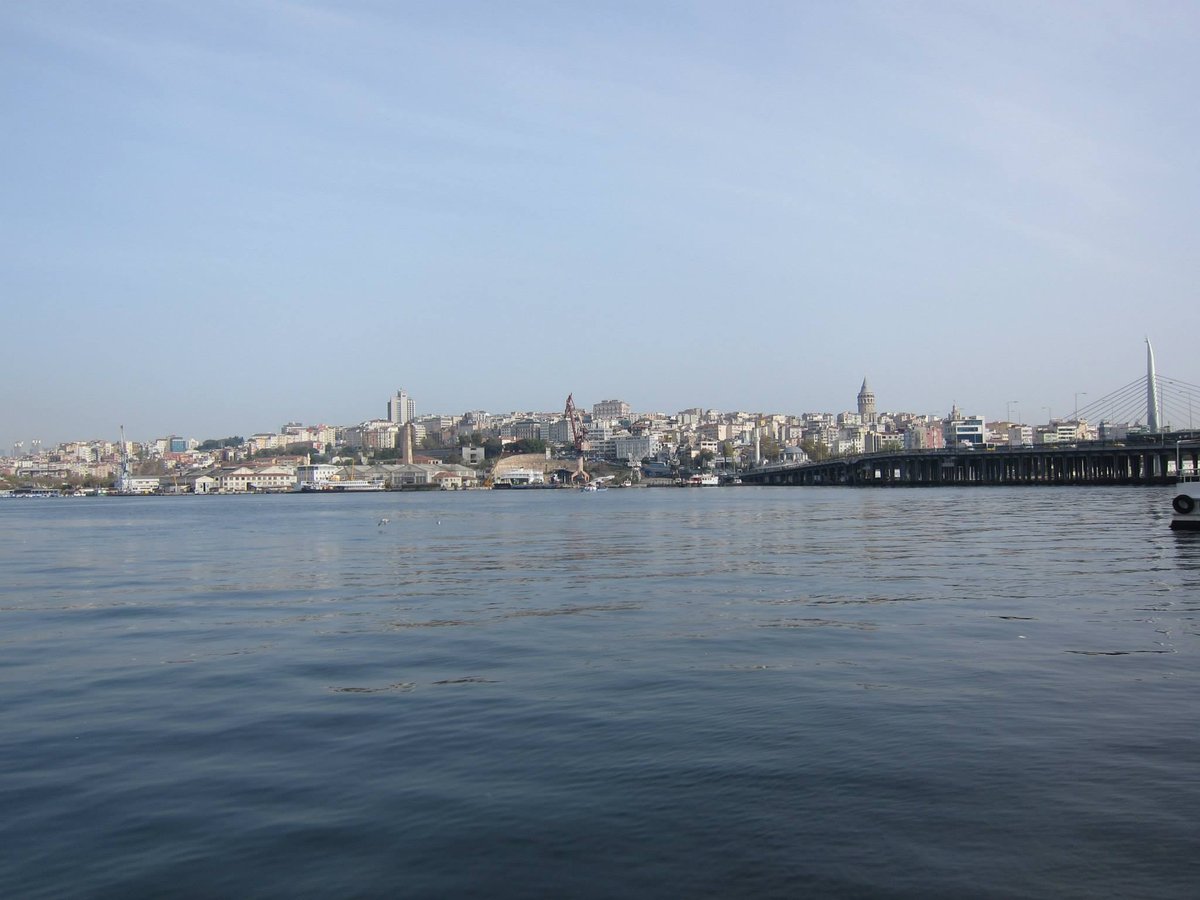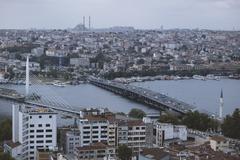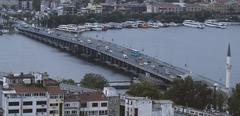
Atatürk Bridge: Visiting Hours, Tickets, and Historical Significance in Istanbul
Date: 15/06/2025
Introduction
Spanning the storied waters of the Golden Horn, the Atatürk Bridge (Atatürk Köprüsü)—historically called Unkapanı Bridge or Hayratiye Köprüsü—stands as a testament to Istanbul’s dynamic evolution. Since its inception in 1836 under Sultan Mahmud II, the bridge has witnessed the city’s transformation from an imperial capital to a vibrant global metropolis. More than a crucial transit link connecting the Unkapanı (Fatih) and Azapkapı (Beyoğlu) neighborhoods, Atatürk Bridge is a cultural icon, offering sweeping city views, everyday urban life, and proximity to major historic sites.
This guide presents in-depth historical background, architectural details, practical visitor information (including hours, tickets, and accessibility), and highlights the bridge’s urban and cultural significance. Whether you are a historian, engineer, photographer, or traveler, the Atatürk Bridge offers a unique window into Istanbul’s past and present.
Table of Contents
- Historical Overview
- Architectural and Engineering Features
- Cultural and Social Role
- Visitor Information
- Recent Developments and Preservation
- FAQ
- Conclusion
- Call to Action
- Visuals and Media
- Key Facts and Figures
- Sources and Further Reading
Historical Overview
Origins and Early Construction
The original bridge, built in 1836 under Sultan Mahmud II, was a wooden pontoon structure designed to float on the Golden Horn. Known as the Hayratiye Köprüsü (“Charity Bridge”), it was remarkable for being toll-free, which encouraged social and economic activity between the city’s diverse districts. The bridge was constructed by Ahmed Fevzi Pasha at the Haliç Shipyards, measured 400 meters in length and 10 meters in width, and could open to allow ships to pass. The Sultan’s ceremonial crossing on horseback marked its inauguration (Atatürk Bridge Wikipedia page).
Evolution and Rebuilding
As urbanization accelerated, the original wooden bridge was replaced in 1875 by a larger, 780-meter metal floating bridge, built by a French company. This new bridge kept pace with Istanbul’s growing traffic and symbolized technological advancement. After serving the city for decades, it was replaced in 1912 by the relocated third Galata Bridge. This temporary solution was destroyed by a storm in 1936, necessitating further reconstruction (Number One Property’s bridges overview).
The Modern Atatürk Bridge
Construction of the current Atatürk Bridge began in 1936 and was completed in 1940. This incarnation represents a blend of traditional pontoon design and early 20th-century engineering, with reinforced concrete and steel elements. The bridge spans 477 meters and is 25 meters wide, accommodating both vehicles and pedestrians. In 1954, its deck was covered with asphalt to facilitate modern traffic. The bridge was officially named after Mustafa Kemal Atatürk, founder of the Turkish Republic, making it the only Istanbul bridge dedicated to him (wikiwand).
Significance and Urban Impact
The Atatürk Bridge has played a central role in Istanbul’s urban growth. By connecting Fatih and Beyoğlu, it facilitated the expansion of residential and commercial districts away from the Golden Horn’s waterfront. The bridge’s toll-free status and integration with major thoroughfares like the E-5 and TEM highways have contributed to the decentralization of the city’s commercial core and the development of new neighborhoods (ITU Space Syntax Symposium).
Architectural and Engineering Features
- Type: Road bridge (highway bridge)
- Length: 477 meters (1,565 feet)
- Width: 25 meters (82 feet)
- Structure: Reinforced concrete and steel superstructure, supported by piers anchored in the Golden Horn
- Deck: Wide, multi-lane carriageway with pedestrian walkways on both sides
- Railings: Metal for safety and enhanced views
The bridge’s design is functional and durable, prioritizing strength and accessibility. Recent renovations have further strengthened its structure and improved integration with modern transport, notably the T5 tram line (absoluteistanbul.com).
Cultural and Social Role
Atatürk Bridge is more than infrastructure—it is an urban gathering point. Locals and tourists walk its length for panoramic views, and fishermen line its rails, continuing a generations-old tradition. The bridge is part of annual events like the Istanbul Marathon and is illuminated at night, creating a picturesque scene over the Golden Horn. Its strategic location connects neighborhoods with unique cultural and religious heritage, such as the historic quarters of Fatih and the cosmopolitan Beyoğlu (Istanbul.tips).
Visitor Information
Visiting Hours and Tickets
- Hours: Open 24 hours a day, 7 days a week
- Tickets: No entrance fee or tickets required
Accessibility
- Pedestrian Access: Wide sidewalks on both sides for walking and sightseeing
- Wheelchair Access: Sidewalks are generally accessible, though some ramps may be steep; assistance may be needed in some areas
- Lighting: Well-lit at night for safety and ambiance
How to Get There
- Tram: T5 tram stops at Unkapanı, near the southern end
- Bus: Numerous bus routes serve both Unkapanı and Azapkapı
- Metro: M2 line (Şişhane station) is within walking distance of the northern end
- Ferry: Golden Horn ferries link nearby neighborhoods for scenic access
- On Foot or Bike: Walkways are wide enough for pedestrians and cautious cyclists
Nearby Attractions and Photo Spots
- Galata Tower: Iconic medieval tower, a short walk from the northern end (travelnotesandbeyond.com)
- Beyoğlu and Istiklal Avenue: Istanbul’s vibrant shopping and cultural district
- Süleymaniye Mosque: Architectural masterpiece just south of the bridge
- Golden Horn Promenade: Parks and walkways along both shores
Guided Tours and Events
While there are no tours dedicated exclusively to Atatürk Bridge, many walking and city tours of the Golden Horn or historic peninsula include it as a highlight, offering historical context and photo opportunities.
Recent Developments and Preservation
Major renovations between 2021 and 2022 improved the Unkapanı junction and integrated the T5 tram line for smoother traffic and public transit. Plans for a tunnel under the Golden Horn were postponed, ensuring the bridge remains an essential part of Istanbul’s infrastructure (Atatürk Bridge Wikipedia page).
FAQ
Q: What are the Atatürk Bridge visiting hours?
A: Open 24/7 for pedestrians and vehicles.
Q: Is there an entrance fee or ticket required?
A: No, the bridge is free to access.
Q: How do I get to Atatürk Bridge?
A: Use the T5 tram to Unkapanı, the M2 metro to Şişhane, or various bus lines.
Q: Are guided tours available?
A: No dedicated tours, but many city tours include the bridge.
Q: Is the bridge wheelchair accessible?
A: Mostly accessible, though some ramps may be steep and may require assistance.
Q: What are the best times to visit?
A: Sunrise and sunset offer the most striking views and best light for photography.
Conclusion
Atatürk Bridge is an essential thread in the fabric of Istanbul, blending historical legacy, modern engineering, and vibrant city life. It is both a route and a destination—offering urban exploration, panoramic vistas, and a tangible connection to Istanbul’s layered history. With round-the-clock, free access and seamless integration into the city’s transport network, it stands as a must-visit for anyone seeking to experience the real Istanbul.
Call to Action
Ready to experience Istanbul from the Atatürk Bridge? Download the Audiala app for guided tours, insider tips, and real-time updates. Explore our related articles for more on Istanbul’s historical sites, and follow us for the latest travel inspiration and event news.
Visuals and Media
Recommended visuals:
- High-resolution images of Atatürk Bridge at sunrise and sunset
- Panoramic photos of the Golden Horn from the bridge
- Pictures of local fishermen and street life
Alt tags: “Atatürk Bridge Istanbul sunrise”, “Golden Horn view from Atatürk Bridge”, “Fishermen on Atatürk Bridge”
Interactive map: Embed a map with the bridge’s location and nearby attractions for enhanced visitor planning.
Key Facts and Figures
- First construction: 1836 (wooden pontoon bridge)
- Rebuilds: 1875 (metal bridge), 1912 (relocated Galata Bridge), 1936–1940 (current structure)
- Current length: 477 meters (1,565 feet)
- Width: 25 meters (82 feet)
- Location: Connects Unkapanı (Fatih) and Azapkapı (Beyoğlu)
- Recent renovations: 2021–2022 (tram integration and junction upgrades)
- Features: Multi-lane highway, pedestrian walkways, panoramic views
Sources and Further Reading
- Atatürk Bridge Wikipedia page
- Atatürk Bridge on Wikiwand
- Istanbul.tips
- Number One Property: The Bridges of Istanbul
- Istanbul.com: Visiting Atatürk Bridge
- ITU Space Syntax Symposium
- Travel Notes and Beyond: 3 Days in Istanbul























































































































